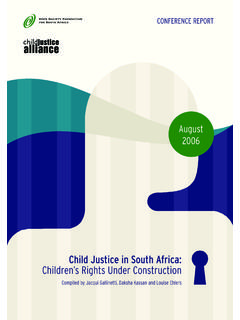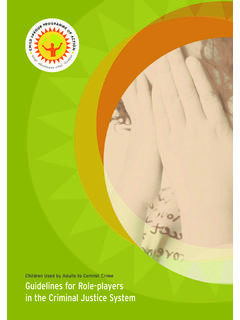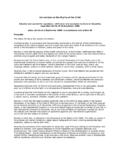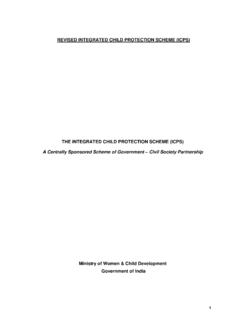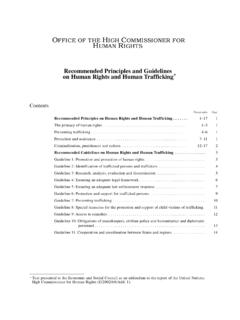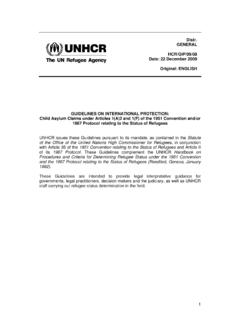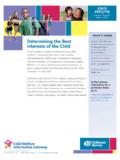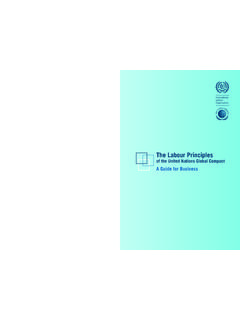Transcription of Getting to know the Child Justice Act
1 Getting to know the Child Justice ActJacqui GallinettiGetting to know the Child Justice ActJacqui GallinettiPublished byThe Child Justice Alliancec/o The Children s Rights Project, Community Law CentreUniversity of the Western CapePrivate Bag X17 Bellville, 7535 Copies of this publication can be obtained from: The Children s Rights Project, Community Law Centre, University of the Western Cape, Private Bag X17, Bellville, 7535. Tel: 021 959 2950, Fax: 021 959 2411, email: views expressed in this publication are in all cases those of the writer concerned and do not necessarily reflect the views of the Open Society Foundation for South Africa, the Child Justice Alliance or the Community Law Centre, University of the Western Cape. ISBN No: 978-1-86808-699-3 Copyright The Child Justice Alliance, c/o The Chidren s Rights Project, Community Law Centre (University of the Western Cape), informationJacqui Gallinetti is a Senior Lecturer in the Faculty of Law, University of the Western Cape.
2 She is also the former Project Co-ordinator of the Children s Rights Project of the Community Law Centre. Legal DisclaimerInformation contained in this publication is for general information on the provisions of the Child Justice Act 75 of 2008. In particular, the information contained in this book does not constitute any form of specific legal advice but rather contains an overview of the Act for purposes of awareness. AcknowledgmentsThe Child Justice Alliance wishes to thank the Open Society Foundation for South Africa for its generous financial support in producing this publication. The Alliance would also like to thank Jacqui Gallinetti, for drafting the contents of this publication, and the members of the Child Justice Alliance Driver Group for their useful input and comments on earlier Kassan and Lorenzo WakefieldDesign and layoutOut of the Blue Creative Communication Solutions, 021 947 3508, p3 PrefaceThis publication is intended to provide the reader with a simple overview of the contents of the Child Justice Act 75 of 2008 (the Act).
3 It attempts to reduce the legalise of the Act; remove constant cross-references to other sections; and bring themes together in a logical and user-friendly is not intended to be a commentary on the provisions of the Act nor a comparison of the Act with the 2002 and 2007 versions of the Child Justice Bills that informed its final content. Nor is the publication intended to constitute a type of training material on the Act. This publication should rather be used as an easy reference source when there is confusion about some of the provisions of the Act and what they actually are intended to mean. In addition, it sets out as best as possible the duties of the key role-players at the end of each section. It also provides a list of sources which the reader can refer to for further information if needed. ContentsPreface ..3 Terms and abbreviations.
4 6 Introduction ..7 International and constitutional principles underpinning the new law ..9 Preamble, objects, guiding principles, definitions and key role-players in the Act ..12 Scope and application of the Act ..15 Age and criminal capacity ..17 Methods of securing a Child s attendance at the preliminary inquiry ..23 Pre-trial detention ..26 Pre-trial assessment ..33 The preliminary inquiry ..38 Diversion ..43 The Child Justice court ..51 Sentencing ..53 Legal representation ..58 Expungement of records ..60 General provisions ..62 Useful websites ..64 Appendix A: Map illustrating a Child s passage through the criminal Justice system ..65 Appendix B: Schedule of offences ..66 Terms and abbreviationsthe Act The Child Justice Act 75 of 2008the Commission The South African Law Reform CommissionBeijing Rules The United Nations Standard Minimum Rules on the Administration of Juvenile JusticeACRWC African Charter on the Rights and Welfare of the ChildCRC Criminal Record CentreCUBAC Children Used By Adults to Commit CrimeCPA Criminal Procedure Act 51 of 1977 DPP Director of Public ProsecutionsIMC Inter-Ministerial Committee on Young People at RiskISCCJ Inter-Sectoral Committee for Child JusticeNPA National Prosecuting AuthoritySAPS South African Police ServiceUNCRC United Nations Convention on the Rights of the ChildUN JDL United Nations Rules for the Protection of Juveniles Deprived of their Liberty p7 IntroductionThe Child Justice Act 75 of 2008 (the Act) has had a long and tumultuous history.
5 The process which resulted in the Act being signed into law on 7 May 2009 began in late 1996 with the appointment of a Project Committee of the South African Law Commission (as it was then known but now known as the South African Law Reform Commission) to investigate juvenile Justice . This Committee began work in 1997 and in 2000 finalised its Report on Juvenile Justice together with a draft Child Justice Bill. This draft Bill was submitted to the Department of Justice and in 2002 it was introduced to parliament as Bill 49 of 2002. The law reform process that resulted in the Act consisted of varied consultations, research and debates. Firstly, the Project Committee prepared an Issue Paper followed by a Discussion Paper, both of which were distributed widely in order to elicit comments. The subsequent responses were then collated into their Report on Juvenile Justice released in 2000.
6 One of the major innovations regarding the consultative process undertaken by the South African Law Reform Commission (the Commission) was the fact that they undertook a consultation study with children. The purpose of this endeavour was to ensure that children s voices were also heard in the drafting of new laws that affected them. The Project Committee also commissioned a costing of the Bill in order to comply with fiscal requirements for new legislation and held workshops on issues such as age and criminal capacity. Secondly, after the Commission finalised its work, civil society also embarked on a series of consultations and undertook various studies as part of its preparations for the Bill being debated in parliament. The Child Justice Alliance, a civil society network established in 2001 to garner support for the Bill, held workshops in all 9 provinces in 2001.
7 It has also produced a range of research reports including two quantitative studies of the criminal Justice system pertaining to children in South Africa (one dealing with the period 1995 2001 and the other dated 2007); an annotated bibliography of all Child Justice publications in South Africa and a baseline study of children in the criminal Justice system in 3 magisterial districts. The Alliance also conducted a follow-up Child consultation study on the draft Bill produced by the Commission. Finally, after the Bill was introduced into parliament in 2002, it was the subject of extensive debates during 2003, and again (unusually but on account of the long delays in processing the Bill) in 2008. These debates have enriched the p8child Justice milieu as they have allowed all stakeholders and role-players including parliamentarians, academics, activists, members of the executive and practitioners to examine all the issues in great detail, listen to opposing views and reach compromises on controversial issues.
8 The product is a law that creates a new procedural framework for dealing with children who come into conflict with the law. It represents a rights-based approach to children accused of committing crimes. However, it also seeks to ensure children s accountability and respect for the fundamental freedoms of others, and through the use of diversion, alternative sentencing and restorative Justice prevent crime and promote public safety. p9 International lawWhile there is a long history of developments in Child Justice before the United Nations Convention on the Rights of the Child (UNCRC), the UNCRC and related international instruments provide the seminal international framework within which children in conflict with the law should be managed. In addition there are a number of principles, minimum rules and standards which deal specifically with children in conflict with the law.
9 Prominent in this regard are the United Nations Standard Minimum Rules on the Administration of Juvenile Justice (Beijing Rules) and the United Nations Rules for the Protection of Juveniles Deprived of their Liberty (UN JDL Rules), adopted in 1990. By Resolution 45/113 of 14 December 1990, the United Nations General Assembly adopted the UN JDL Rules. Section 3 of the Fundamental Perspectives set out in the UN JDL Rules sets out the purpose thereof, namely: [t]he Rules are intended to establish minimum standards accepted by the United Nations for the protection of juveniles deprived of their liberty in all forms, consistent with human rights and fundamental freedoms, and with a view to counteracting the detrimental effects of all types of detention and to fostering integration in society. This is elaborated on further by section 5, which states: [t]he Rules are designed to serve as convenient standards of reference and to provide encouragement and guidance to professionals involved in the management of the juvenile Justice system.
10 Thus, the UN JDL Rules do not have the same force of law as the provisions of the South African Constitution or the international obligations that South Africa has incurred on account of its ratification of the UNCRC, which is an international treaty agreement. Rather, the UN JDL Rules should guide the application of the rights contained in both documents. The deprivation of a Child s liberty and the administration of juvenile Justice are dealt with in article 37 and article 40 of the UNCRC respectively. Articles 40(1) (4) provide a concise yet comprehensive framework within which States are obliged to fashion a Child Justice system. The provision covers issues such as: non-discrimination; the Child s right to dignity and worth as well as the right to privacy; International and constitutional principles underpinning the new law p10 the need for children to respect the human rights and fundamental freedoms of others; the need to take the age of the Child and the desirability of promoting the Child s reintegration and the Child s assuming a constructive role in society into account; the presumption of innocence; the Child s right to be informed of charges against him or her; the right to legal representation; the right to a speedy and fair trial by an impartial authority or judicial body; the right to have decisions subject to review or appeal.
